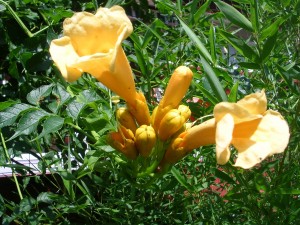Other Name
trumpet creeper
Sun Requirements
full sun, part sun, part shade
Bloom Period and Seasonal Color
Mid summer to fall with red, orange or yellow flowers
Mature Height x Spread
10 to 30 feet x 5 to 10 feet
Added Benefits
attracts beneficials, attracts hummingbirds, native, deer resistant
This aggressive, woody vine produces large clusters of trumpet-shaped flowers, prized by hummingbirds. The flowers give way to bean-shaped pods. It also has attractive, long dark green leaves made of 7, 9 or 11 leaflets. Trumpet vines are easy to grow. In fact, the problem with trumpet vine isn’t growing it, but restraining it. It covered my deck in my old house after only a few years of growing. It needs yearly attention to pruning and supporting to keep the vine in bounds and growing vertically. The vine has aerial rootlets that climb on walls and structures, but since it is so heavy it may need other supports to keep it vertical. For that reason, it’s a great addition to trellises, fences and arbors.
When, Where and How to Plant
Trumpet vines are hardy throughout New England, but may experience some winter dieback in colder regions. Purchase plants at a local garden center and plant from spring to early fall in full to part sun on well-drained, moist soil. Space plants 5 to 10 feet apart.
Growing Tips
Trumpet vines don’t need additional fertilizer and actually thrive on only moderately fertile soil. Add a thin layer of compost in spring to keep the vine healthy. Trumpet vine does need moist soil, however, so water well and mulch for bark mulch each spring for moisture retention and weed prevention.
Regional Advice and Care
Trumpet vine is slow to leaf out in spring, so don’t assume it has died if the branches are still bare while other shrubs have leaves or flowers. Trumpet vine can become too aggressive for its space and needs to be pruned back each spring. Prune out any dead, broken or diseased branches first. The flowers forms on new growth, so in spring after it leafs out, prune back wayward branches to the trunk and shorter structural branches. This will stimulate more new growth and potentially more flowers. Trumpet vine also can be an invasive vine in New England, so remove spent flowers to prevent seed from forming and cut back any new shoots arising from the roots.
Companion Planting and Design
Grow trumpet vines up walls, arbors, pergolas, fences and lampposts. It looks great as a backdrop to other tall perennial flowers, such as coneflowers and bee balm. It grows well in part shade, creating a dark green wall of foliage, but it won’t flower as well as vines grown in full sun. Trumpet vine can also grow over walls or down banks to cover a slope.
Try These
‘Crimson Trumpet’ has deep red flowers. ‘Indian Summer’ has orange-red colored flowers and stronger aerial roots. ‘Flava’ has yellow colored flowers. ‘Variegata’ has orange flowers with white and green leaves.
Excerpted from my book, New England Getting Started Garden Guide.



